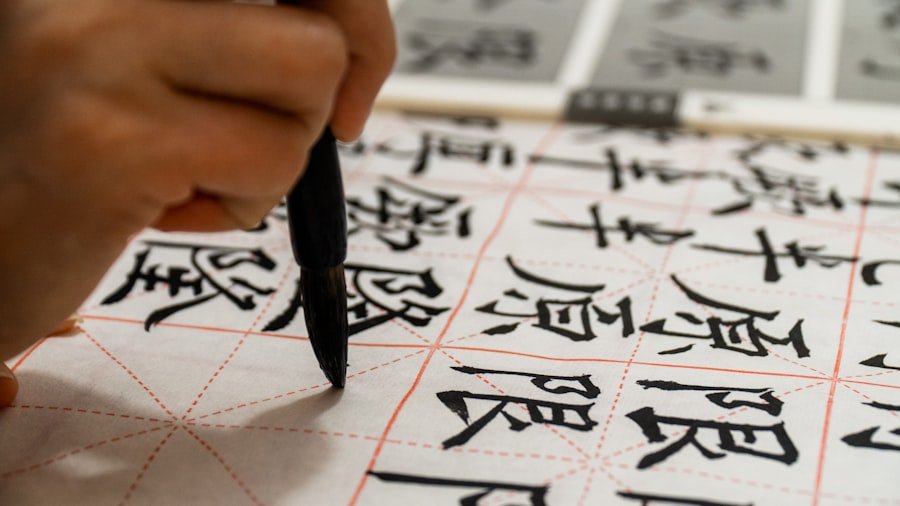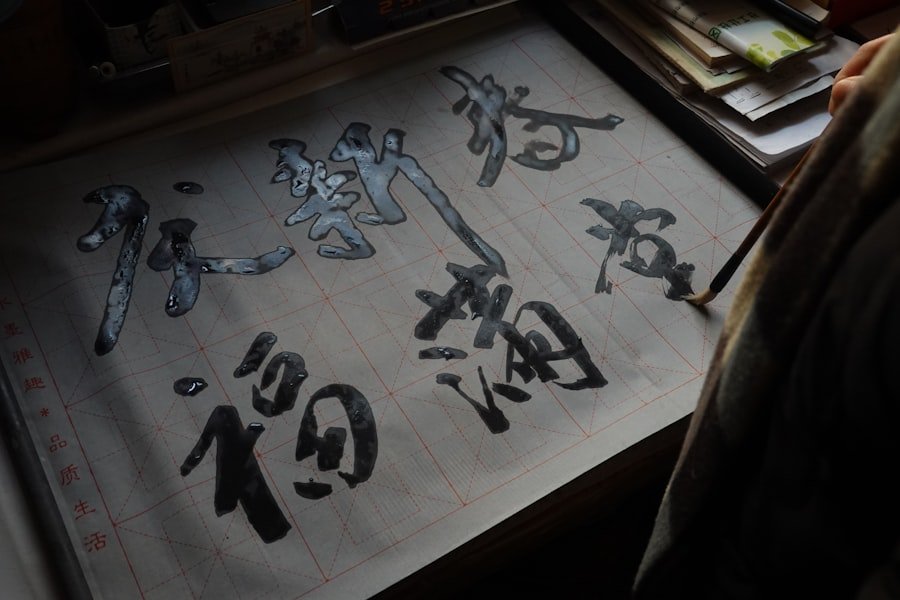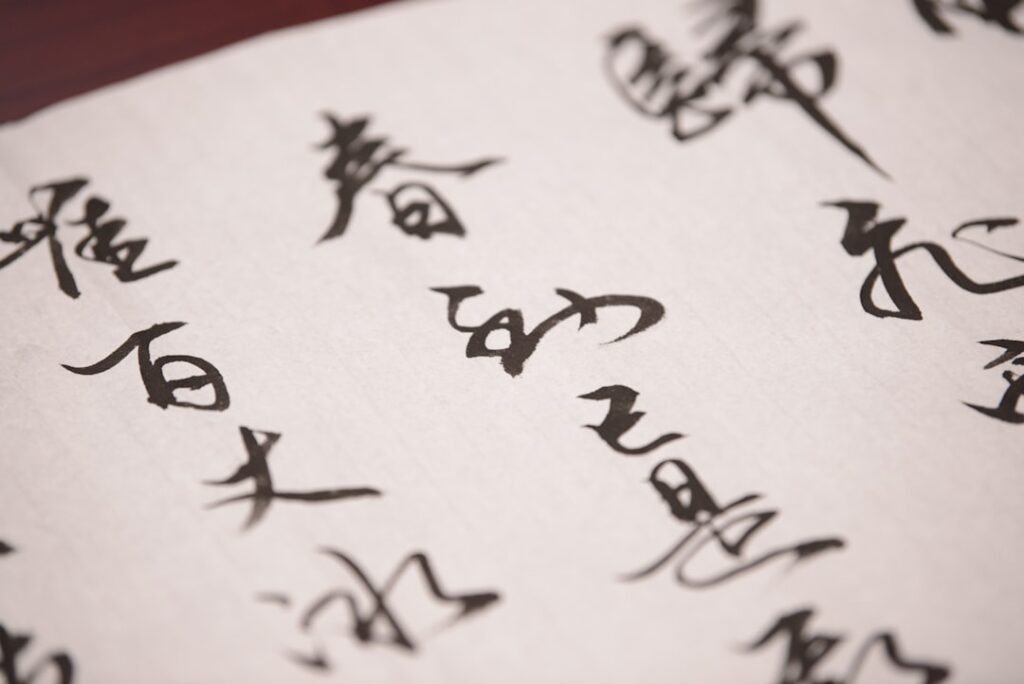Chinese calligraphy is an ancient art form that transcends mere writing; it is a profound expression of culture, philosophy, and emotion. At its core lies the brush, a simple yet versatile tool that, when wielded with skill, can create a myriad of strokes and styles. As practitioners delve deeper into the world of calligraphy, they encounter advanced brush techniques that elevate their work from the ordinary to the extraordinary.
These techniques not only enhance the aesthetic quality of the characters but also allow the artist to convey deeper meanings and emotions through their brushwork. The journey into advanced brush techniques is both challenging and rewarding. It requires a deep understanding of the brush’s anatomy, the dynamics of stroke production, and the subtleties of pressure and angle.
As students progress, they learn to manipulate the brush in ways that create varied textures and forms, transforming simple characters into intricate works of art. This article will explore the nuances of advanced brush techniques, focusing on the centre tip and side tip of the brush, and how these elements can be harnessed to achieve precision, fluidity, and expression in Chinese calligraphy. Master the art of Chinese calligraphy. Enroll now at the LC Chinese School in Oslo.
Table of Contents
ToggleSummary
- Understanding the Center Tip and Side Tip of the Brush is crucial for mastering advanced brush techniques in Chinese calligraphy.
- Utilising the Center Tip for Precision and Detail allows for intricate and delicate strokes in calligraphy.
- Harnessing the Side Tip for Fluidity and Expression adds a dynamic and expressive quality to the brushwork.
- Experimenting with Pressure and Angle for Different Results can create varied effects and textures in Chinese calligraphy.
- Practising and Improving Brush Control is essential for mastering the balance between Center and Side Tip usage in Chinese calligraphy.
Understanding the Center Tip and Side Tip of the Brush
To master advanced brush techniques, one must first understand the fundamental components of the brush itself. The centre tip and side tip are two critical aspects that define how strokes are formed. The centre tip is typically used for creating bold, defined lines that require precision.
It is the part of the brush that makes direct contact with the paper when executing vertical or horizontal strokes. Understanding how to control this part of the brush is essential for achieving clarity and sharpness in characters. Conversely, the side tip of the brush offers a different set of possibilities.
When used correctly, it allows for a more fluid and expressive style, ideal for creating sweeping curves and dynamic movements. The side tip can produce softer lines that evoke a sense of motion and grace. By mastering both tips, calligraphers can expand their repertoire, enabling them to switch between precision and fluidity as needed.
This understanding lays the groundwork for exploring how each tip can be utilised effectively in various contexts.
Differences in Stroke Thickness and Control

The thickness of strokes in Chinese calligraphy is not merely a matter of aesthetics; it plays a crucial role in conveying meaning and emotion. The centre tip typically produces thicker, more pronounced lines that can convey strength and stability. This is particularly important in traditional styles where boldness is often associated with authority and confidence.
Mastering control over stroke thickness using the centre tip allows calligraphers to create characters that stand out on the page, drawing the viewer’s eye. In contrast, strokes created with the side tip tend to be thinner and more delicate. This technique is particularly effective for adding nuance and subtlety to characters.
The ability to vary stroke thickness through pressure and angle creates a dynamic interplay between boldness and fragility. Calligraphers who can seamlessly transition between these two styles can imbue their work with a sense of depth and complexity, allowing viewers to engage with the characters on multiple levels.
Utilising the Center Tip for Precision and Detail
The centre tip is indispensable for achieving precision in Chinese calligraphy. When executing intricate characters or detailed components, calligraphers rely on this part of the brush to ensure clarity and definition. By applying consistent pressure and maintaining a steady hand, artists can create sharp lines that delineate each stroke with accuracy.
This level of control is particularly important in traditional scripts where every detail contributes to the overall harmony of the piece. Moreover, utilising the centre tip effectively requires an understanding of rhythm and flow. Calligraphers must develop a sense of timing as they move the brush across the paper, allowing for a natural progression from one stroke to another.
This rhythmic approach not only enhances precision but also adds an element of grace to the work. As students practise using the centre tip, they begin to appreciate how even slight variations in pressure can dramatically alter the character’s appearance, leading to a more refined and polished final product.
Harnessing the Side Tip for Fluidity and Expression
While precision is vital in calligraphy, fluidity and expression are equally important in conveying emotion through brushwork. The side tip of the brush is particularly well-suited for this purpose, allowing artists to create sweeping strokes that evoke movement and energy. By tilting the brush at different angles, calligraphers can produce varied line qualities that add dynamism to their work.
Harnessing the side tip effectively requires a certain level of confidence and spontaneity. Unlike the controlled strokes produced by the centre tip, side-tip strokes often embrace a more instinctive approach. This freedom allows artists to express their individuality and creativity, resulting in pieces that resonate on a personal level.
As students experiment with this technique, they discover how to balance control with spontaneity, leading to a unique style that reflects their artistic voice.
Combining Both Tips for Varied Effects

One of the most exciting aspects of advanced brush techniques is the ability to combine both the centre tip and side tip for varied effects. By integrating these two approaches, calligraphers can create compositions that are rich in texture and visual interest. For instance, a character may begin with bold strokes from the centre tip before transitioning into delicate flourishes from the side tip, resulting in a harmonious blend of strength and grace.
This combination not only enhances the aesthetic appeal of the work but also allows for greater emotional expression. The interplay between boldness and delicacy can convey complex feelings, inviting viewers to engage with the piece on a deeper level. As students practise this technique, they learn to navigate between different styles seamlessly, developing a versatile approach that enriches their overall calligraphic practice.
Mastering the Balance between Center and Side Tip Usage
Achieving mastery in Chinese calligraphy involves finding a balance between centre tip and side tip usage. This balance is not merely technical; it also reflects an artist’s understanding of their own style and intent. Calligraphers must consider how each stroke contributes to the overall composition and message they wish to convey.
Striking this balance requires practice, patience, and a willingness to experiment. As students progress in their studies, they begin to develop an intuitive sense of when to employ each tip based on their artistic vision. This mastery allows them to create works that are not only visually striking but also deeply meaningful.
By embracing both techniques, calligraphers can cultivate a unique voice that resonates with viewers while honouring the rich traditions of Chinese calligraphy.
Techniques for Creating Depth and Dimension
Creating depth and dimension in Chinese calligraphy adds an extra layer of complexity to each piece. Techniques such as varying stroke thickness, manipulating pressure, and adjusting angle all contribute to this effect. By employing both centre and side tips strategically, artists can create characters that appear three-dimensional on paper.
One effective method for achieving depth is through layering strokes. By applying multiple layers using different tips, calligraphers can build up texture that draws viewers’ eyes into the work. Additionally, incorporating negative space thoughtfully enhances depth by allowing certain areas to breathe while others remain bold and defined.
As students explore these techniques, they discover how depth can transform their calligraphy from flat representations into vibrant expressions of art.
Experimenting with Pressure and Angle for Different Results
The beauty of Chinese calligraphy lies in its versatility; even slight adjustments in pressure or angle can yield dramatically different results. Calligraphers are encouraged to experiment with these variables as they develop their skills further. For instance, applying more pressure with the centre tip can create thicker lines that command attention, while lighter pressure may yield softer strokes that evoke gentleness.
Similarly, altering the angle at which the brush meets the paper can produce varied line qualities that enhance expressiveness. A steeper angle may result in sharper edges, while a flatter angle can create broader strokes with more fluidity. This experimentation fosters creativity and encourages artists to push boundaries within their practice, leading to innovative approaches that reflect their unique perspectives.
Tips for Practising and Improving Brush Control
Improving brush control is essential for mastering advanced techniques in Chinese calligraphy. One effective practice is to engage in repetitive exercises focused on specific strokes or characters. By dedicating time to these exercises, students can develop muscle memory that enhances their overall control over the brush.
Additionally, maintaining a relaxed grip on the brush allows for greater flexibility during movement. Tension can hinder fluidity; therefore, finding a comfortable hold is crucial for achieving smooth strokes. Practising mindfulness while working also helps artists connect with their breath and rhythm, further enhancing their control over each stroke.
Embracing the Versatility of Brush Techniques in Chinese Calligraphy
In conclusion, advanced brush techniques in Chinese calligraphy offer artists an expansive realm of possibilities for expression and creativity. By understanding the roles of both centre tip and side tip usage, practitioners can create works that are rich in texture, depth, and emotion. The interplay between precision and fluidity allows for a dynamic exploration of character forms that resonate deeply with viewers.
For those eager to delve into this captivating art form further, LC Chinese School in Oslo offers exceptional courses focused on Chinese calligraphy. These classes provide an opportunity for students to learn from experienced instructors who guide them through advanced techniques while fostering individual artistic expression. Embracing these versatile brush techniques not only enhances one’s skills but also deepens appreciation for this timeless art form steeped in history and culture.
Whether you are a beginner or an experienced artist looking to refine your skills, LC Chinese School provides an enriching environment where you can explore your passion for Chinese calligraphy fully.
Master the art of Chinese calligraphy. Enroll now at the LC Chinese School in Oslo.







